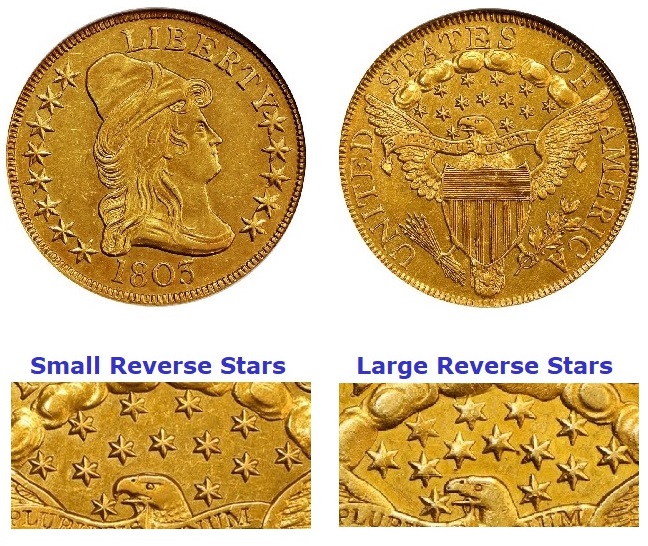1803 Capped Bust Large Eagle $10 Eagle, Large Reverse Stars
The “Guide Book of United States Coins”, perhaps better known as the “Redbook,” reports a mintage of 15,017 for the 1803 Capped Bust $10 eagle.(1) To understand the true rarity of this date, more context is necessary.
There are six die varieties known for the 1803. Varieties BD-1, BD-2, BD-3, and BD-4 all display small reverse stars. Of the small star varieties, BD-3 is the most frequently encountered.(2) Altogether, there are estimated to be 250 pieces of the small star varieties existing today.(3)
The reverse of BD-5 was punched with large stars. There is a mystery 14th star, very small and faint, present in the rightmost cloud. In 1966, numismatist Harry Bass was the first to discover the extra star (although other diagnostics identifying the BD-6 variety were developed long before then). Why the extra star was placed there will probably remain a riddle forever.
The extremely rare BD-6 also features large stars, but the 14th star is not present. Less than 10 examples are known today.(4) What’s more, the 1803-BD-6 also holds the distinction as the last circulation strike of the Capped Bust 1795-1804 eagles. Die state study shows the BD-6 was struck after the 1804 issue completed its run.(5)
In the Rare Coins 101 analysis of the 1803 eagles, the large star varieties (primarily the BD-5 – that’s the one with the extra mystery star), outpaced the small star versions and qualified as a Key Date recommendation.
The value trend history since 1990 for the 1803 large stars eagle is a bit unusual for such a bona fide rarity. Prices shot through the roof in 2006-10, but then slowly drifted down to less than half their peak value, but are still very high compared to their levels in the early 1990’s. One could conclude they were temporarily overpriced in those coin bull market years, but that most certainly is not the case today.
| Estimated survivors in all grades: 258 ?
The survivor estimate from PCGS represents an average of one or more experts' opinions as to how many examples survive of a particular coin in all grades. Survival estimates include coins that are raw, certified by PCGS, and certified by other grading services. Learn more at PCGS. |
| PCGS Rarity Scale: 6.6 ?
The 'PCGS CoinFacts Rarity Scale' assesses the relative rarity of all U.S. coins, based on estimated surviving examples. The scale runs from 1.0 to 10.0. The higher the number, the rarer the coin.
Learn more at PCGS. |
| Click HERE to check for availability on eBay** |
Preview of eBay selection (for a more complete ebay search, click HERE link above):
 |
|
| Trendline Avg = 14.34 | GOOD |
Historic Value Trend Charts:
| Last updated 9-6-24 | Return to Key Date Coin List | |
| Compare to Common Date Coin of Same Type | ||
|
|
||
| Download Charts to Your Computer | ||
Sources
1. Yeoman, R.S. and Garrett, Jeff, et al. A Guide Book of United States Coins, 75th ed. Pelham, AL: Whitman Publishing, 2021.
2. PCGS. 1803 $10 Large Reverse Stars (Regular Strike).
3. Stack's Bowers Galleries. 1803 Capped Bust Right Eagle. BD-5, Large Reverse Stars, Extra Star. Aug 2021 Auction.
4. PCGS. 1803 $10 Large Reverse Stars (Regular Strike).
5. Heritage Auctions. 1803 $10 Large Stars Reverse. Jun 2008 Auction.
**Many very fine coin dealers sell on eBay. At any point in time, there may be over one million search results for United States coins. This includes quite a few of the recommendations on our Key Date Coin List.
If you’re thinking about purchasing a rare coin, eBay is certainly worth a look. For your convenience, the links from this site to eBay are coded to bring up only coins certified by PCGS and NGC.
As is always, always the case, never buy a valuable coin from a seller whose trustworthiness cannot be verified. Learn more about this at our chapter Best Places to Buy Coins, which also has a section on doing business on eBay.
In the interest of full disclosure, Rare Coins 101 receives a small commission anytime someone connects to eBay from this site and purchases something.
Coin images by Stack's Bowers Galleries.


